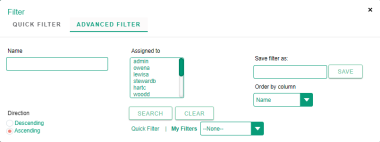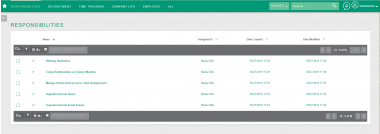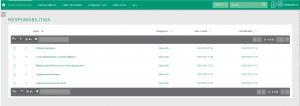Difference between revisions of "Module:Responsibilities"
| Line 10: | Line 10: | ||
|Module-reportable=Yes | |Module-reportable=Yes | ||
|Module-hidden=No | |Module-hidden=No | ||
| − | |Related Screens=File:MintHCM - Responsibilities - List View.png,File:MintHCM - Responsibilities - Record View.png | + | |Related Screens=File:MintHCM - Responsibilities - List View.png,File:MintHCM - Responsibilities - Record View.png, File:MintHCM - Responsibilities - Filters.png |
| − | |Short Description= | + | |Short Description=The 'Responsibilities' module streamlines task management by allowing users to define, assign, and track responsibilities within the organization. Integrated with key modules like Positions, Roles, Appraisal Items, and Activities, it ensures accountability and efficient workflow. |
}} | }} | ||
| + | |||
=={{int:ev-business_description}}== | =={{int:ev-business_description}}== | ||
| − | Responsibilities are | + | ==== Overview ==== |
| + | |||
| + | The 'Responsibilities' module is a cornerstone for effective task management within our system. Users can define, assign, and track responsibilities, fostering accountability. With fields like Name, Assigned to, and Description, it provides a comprehensive framework for articulating and understanding each responsibility. Integrated with 'Positions' and 'Roles,' it aligns duties with organizational structures, promoting clarity in role-based tasks. The module enhances performance management through its association with 'Appraisal Items,' facilitating evaluations based on responsibility fulfillment. In the realm of ongoing projects, the connection with the 'Activities' module ensures tasks align with broader organizational objectives. The user-friendly interface allows for real-time monitoring, ensuring organizations operate with transparency and responsiveness. | ||
| + | |||
| + | ==== Fields ==== | ||
| + | |||
| + | The Responsibilities module is comprised of multiple fields, each meticulously crafted with a distinct purpose in mind, serving to capture and organize essential responsibilities-related information. Here is a detailed explanation of each field: | ||
| + | |||
| + | {| | ||
| + | |- | ||
| + | | width=17% align=right valign=top style="padding-right: 10px; padding-bottom: 7px;" | '''Name''' || || The concise title or description of the responsibility. | ||
| + | |- | ||
| + | | align=right valign=top style="padding-right: 10px; padding-bottom: 7px;" | '''Description''' || || The detailed content outlining the specific tasks and obligations associated with the responsibility. | ||
| + | |- | ||
| + | | align=right valign=top style="padding-right: 10px; padding-bottom: 7px;" | '''Assigned User''' || || The user designated to manage or handle the assigned responsibility. | ||
| + | |- | ||
| + | | align=right valign=top style="padding-right: 10px; padding-bottom: 7px;" | '''Date Created''' || || The date and time when the responsibility was initially created. | ||
| + | |- | ||
| + | | align=right valign=top style="padding-right: 10px; padding-bottom: 7px;" | '''Date Modified''' || || The date and time when the responsibility was last edited or modified. | ||
| + | |} | ||
| + | |||
| + | '''Note:''' Fields marked with an asterisk are required. Saving the record without providing input to them beforehand won't be possible. | ||
| + | |||
| + | ==== Relations ==== | ||
| + | |||
| + | The 'Responsibilities' module is intricately connected with several key modules, amplifying its utility across various aspects of organizational management. These related modules include: | ||
| + | |||
| + | * [[Module:Positions|Positions]] | ||
| + | * [[Module:EmployeeRoles|Roles]] | ||
| + | * [[Module:ResponsibilityActivities|Activities]] | ||
| + | * [[Module:AppraisalItems|Appraisal Items]] | ||
| + | |||
| + | Responsibilities within an organization are often intricately linked to specific positions, and the module seamlessly integrates with the 'Positions' module. This integration allows for the precise alignment of duties with organizational hierarchies, promoting clarity and efficiency. | ||
| + | |||
| + | Moreover, responsibilities can be associated with specific roles within the organization, and the module seamlessly integrates with the 'Roles' module. This ensures that individuals holding particular roles are well-informed about their designated tasks and obligations. | ||
| + | |||
| + | The 'Responsibilities' module significantly contributes to performance management by linking with 'Appraisal Items.' This connection facilitates the evaluation of individuals based on how effectively they fulfill their assigned responsibilities, adding a valuable layer to the appraisal process. | ||
| + | |||
| + | In the dynamic context of ongoing projects and daily operations, the module interfaces seamlessly with the 'Activities' module. By connecting responsibilities to activities, it ensures that tasks are directly aligned with broader organizational goals, promoting a cohesive and goal-oriented work environment. | ||
| + | |||
| + | ==== Role in the Hiring Process ==== | ||
| + | |||
| + | The 'Responsibilities' module plays a crucial role in the hiring process by providing a structured framework for defining and assigning roles and tasks related to recruitment. Within this module, administrators can clearly outline the responsibilities associated with each stage of the hiring process, from creating job descriptions to conducting interviews and evaluating candidates. | ||
| + | |||
| + | Administrators utilize the 'Responsibilities' module to assign specific tasks to individuals or teams involved in the hiring process. This ensures that everyone is aware of their role and responsibilities, fostering collaboration and efficiency. For example, responsibilities may include crafting compelling job descriptions, conducting initial candidate screenings, or coordinating interview schedules. | ||
| − | + | Moreover, the module facilitates accountability during recruitment. By clearly defining responsibilities and assigning them within the system, administrators can easily track the progress of each task. This transparency enhances communication among team members and ensures that critical steps in the hiring process are completed in a timely manner. | |
| − | + | Additionally, the 'Responsibilities' module integrates seamlessly with other hiring-related modules, such as 'Positions' and 'Roles.' This integration allows for the alignment of responsibilities with specific job positions and organizational roles, ensuring that tasks are tailored to the unique requirements of each hiring scenario. | |
{{Module-links}} | {{Module-links}} | ||
{{technical-description}} | {{technical-description}} | ||
{{DevNotes}} | {{DevNotes}} | ||
Revision as of 11:32, 14 November 2023
| Responsibilities | |
|---|---|
| Name: | Responsibilities |
| Tech Name: | Responsibilities |
| Class Name: | Responsibilities |
| Type: | Standard |
| Template: | Security_groups, Assignable, Basic |
| Custom Module: | No |
| Auditable: | Yes |
| Importable: | No |
| Reportable: | Yes |
| Hide module on Main Page: | No |
Contents
[hide]Short Description
The 'Responsibilities' module streamlines task management by allowing users to define, assign, and track responsibilities within the organization. Integrated with key modules like Positions, Roles, Appraisal Items, and Activities, it ensures accountability and efficient workflow.
Business Description
Overview
The 'Responsibilities' module is a cornerstone for effective task management within our system. Users can define, assign, and track responsibilities, fostering accountability. With fields like Name, Assigned to, and Description, it provides a comprehensive framework for articulating and understanding each responsibility. Integrated with 'Positions' and 'Roles,' it aligns duties with organizational structures, promoting clarity in role-based tasks. The module enhances performance management through its association with 'Appraisal Items,' facilitating evaluations based on responsibility fulfillment. In the realm of ongoing projects, the connection with the 'Activities' module ensures tasks align with broader organizational objectives. The user-friendly interface allows for real-time monitoring, ensuring organizations operate with transparency and responsiveness.
Fields
The Responsibilities module is comprised of multiple fields, each meticulously crafted with a distinct purpose in mind, serving to capture and organize essential responsibilities-related information. Here is a detailed explanation of each field:
| Name | The concise title or description of the responsibility. | |
| Description | The detailed content outlining the specific tasks and obligations associated with the responsibility. | |
| Assigned User | The user designated to manage or handle the assigned responsibility. | |
| Date Created | The date and time when the responsibility was initially created. | |
| Date Modified | The date and time when the responsibility was last edited or modified. |
Note: Fields marked with an asterisk are required. Saving the record without providing input to them beforehand won't be possible.
Relations
The 'Responsibilities' module is intricately connected with several key modules, amplifying its utility across various aspects of organizational management. These related modules include:
Responsibilities within an organization are often intricately linked to specific positions, and the module seamlessly integrates with the 'Positions' module. This integration allows for the precise alignment of duties with organizational hierarchies, promoting clarity and efficiency.
Moreover, responsibilities can be associated with specific roles within the organization, and the module seamlessly integrates with the 'Roles' module. This ensures that individuals holding particular roles are well-informed about their designated tasks and obligations.
The 'Responsibilities' module significantly contributes to performance management by linking with 'Appraisal Items.' This connection facilitates the evaluation of individuals based on how effectively they fulfill their assigned responsibilities, adding a valuable layer to the appraisal process.
In the dynamic context of ongoing projects and daily operations, the module interfaces seamlessly with the 'Activities' module. By connecting responsibilities to activities, it ensures that tasks are directly aligned with broader organizational goals, promoting a cohesive and goal-oriented work environment.
Role in the Hiring Process
The 'Responsibilities' module plays a crucial role in the hiring process by providing a structured framework for defining and assigning roles and tasks related to recruitment. Within this module, administrators can clearly outline the responsibilities associated with each stage of the hiring process, from creating job descriptions to conducting interviews and evaluating candidates.
Administrators utilize the 'Responsibilities' module to assign specific tasks to individuals or teams involved in the hiring process. This ensures that everyone is aware of their role and responsibilities, fostering collaboration and efficiency. For example, responsibilities may include crafting compelling job descriptions, conducting initial candidate screenings, or coordinating interview schedules.
Moreover, the module facilitates accountability during recruitment. By clearly defining responsibilities and assigning them within the system, administrators can easily track the progress of each task. This transparency enhances communication among team members and ensures that critical steps in the hiring process are completed in a timely manner.
Additionally, the 'Responsibilities' module integrates seamlessly with other hiring-related modules, such as 'Positions' and 'Roles.' This integration allows for the alignment of responsibilities with specific job positions and organizational roles, ensuring that tasks are tailored to the unique requirements of each hiring scenario.
Processes
Related Processes
| Process | Short Description |
|---|---|
| Job Description | The description of the functionalities associated with workplace |
Related Features
Structure
Fields
| Name | Type | Required | Validations | Visible | Editable |
|---|---|---|---|---|---|
| Assigned to | relate | No | Yes | Yes | |
| Created by | relate | No | Yes | No | |
| Date Created | datetime | No | Yes | No | |
| Date Modified | datetime | No | Yes | No | |
| Description | text | No | Yes | Yes | |
| Modified by Name | relate | No | Yes | No | |
| Name | name | Yes | Yes | Yes |
Relationships
| Laft | Type | Right | Short Description | Relationship |
|---|---|---|---|---|
| Responsibilities | one-to-many | Appraisal Items | Flex relate used in Responsibilities | Relationship: Responsibilities - AppraisalItems |
| Users | one-to-many | Responsibilities | Specific Sugar user can modify many account records, but specific account record last modification was performed by specific user. | Relationship: Users - Responsibilities |
| Users | one-to-many | Responsibilities | Specific Sugar user can create many account records, but specific account record can be created by only one user. | Relationship: Users - Responsibilities |
| Users | one-to-many | Responsibilities | Specific Sugar user can be assigned to many account records, but specific account record can only have one user assigned. | Relationship: Users - Responsibilities |





